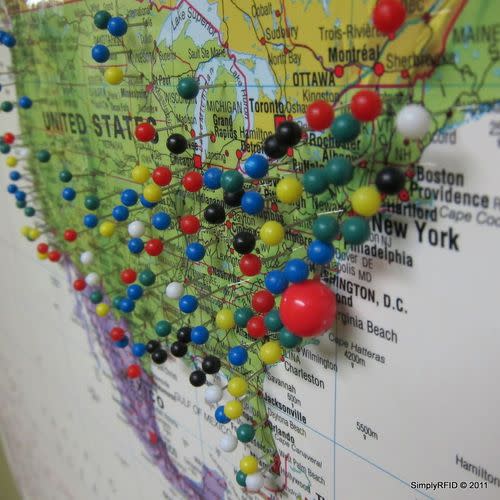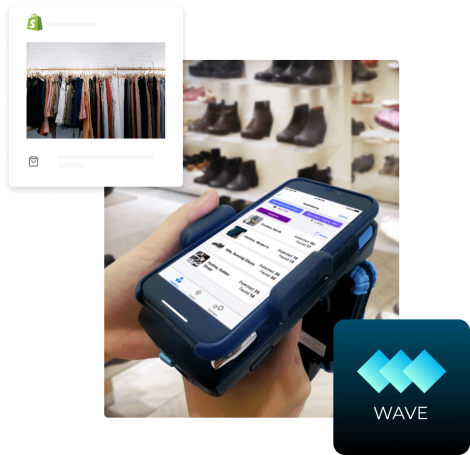Emergency! Whoʼs got that file?

The State Attorneyʼs office in Palm Beach County, Florida, installed an RFID system to tag all of their court dockets (file folders) with RFID labels and instantly locate them in a hallway, inbox or briefcase while going out the front door. At a cost of about 20 cents per file folder, the system recovers its cost through a negligible legal filing fee for each court case.
How does it work? When a docket is created, a small 10cm x 2.5cm (4 inch x 1 inch) RFID tag is programmed, printed and attached to the file. RFID chips are supplied in a label format. They are as thin as any shipping label and can be as small as a postage stamp. Each chip contains a unique number that identifies that docket to the tracking system. From this moment on, RFID readers are searching for this RFID tag. In the case of the State Attorneyʼs Office in Palm Beach County, they installed 132 RFID readers with antennas over four stories of their building. As the files travel through the halls, the RFID tag is located and a central server updates the last known location of the file.
Palm Beach uses dual systems. They have a legal document tracking system called STAC that is designed for legal document creation and management. The RFID tag ID is stored as extra data in their STAC system. When a find-file emergency occurs, the RFID value is checked in the STAC system and a separate RFID locator window opens and shows them where the file is. “Yesterday afternoon at about 3:45 we had our first ʻfind fileʼ emergency since implementing the new RFID system,” commented Lynn Harvey of the State Attorneyʼs Office after the Palm Beach system was implemented. “A Division X file was needed for court this morning. Intake advised that the file had been sent up to Felony but it could not be located anywhere on the third floor. Amy who sits outside my office and had seen me demonstrating the new system came to me with the case number and when I ran it up in STAC and activated the file location system, it displayed that the file was in the mailroom and had been there for 16 minutes. We figured it was in the Division X mailbox so Amy went down and thatʼs exactly where it was. The system works as promised.”
How do I make one of these? There are four components in a document location system.
- The RFID tags which are placed on file folders to track them.
- The RFID readers which look for RFID tags in their surveillance area.
- The RFID printer which programs new RFID tags, and
- The software which manages the RFID readers, thousands of tag movements and tag programming.
The RFID tags used in the system described above are UHF (Ultra High Frequency) 900Mhz passive (no battery) devices. These tags harvest radio waves originating from an RFID reader to respond to the interrogation with a 12 character ID code. The technology used is UHF Gen 2, an open RFID standard also adopted by Wal-Mart and the US Department of Defense. The Gen 2 standard has inspired competition to drive price down and performance up, and is ideal for a low-cost, high-performance file-tracking system. Gen 2 RFID tags perform exceptionally well at ranges up to 18 meters (60 feet) and can be purchased for about 20 cents each.
The State Attorneyʼs office in Palm Beach is using the Alien Higgs chip. Other deployments have successfully deployed the Avery Dennison AD223/AD224 chips.
RFID readers contain antennas that emit RF waves and listen for an RFID tag response. By mounting an RFID reader in a doorway, the system will see every file folder that passes through the door. In some instances, a handheld RFID reader can be useful for locating files in a remote warehouse. In December 2008, SimplyRFiD began supplying an effective RFID handheld called NoxVault with read ranges of over 6 meters (20 feet). As for stationary readers, the State Attorneyʼs office in Palm Beach deployed the ThingMagic Astra and M5 readers, at a price of about $1,000 per RFID reader with antenna. RFID printers program and print the RFID tags. They also verify the tag to ensure it is working ‒ and, reprint it if it isnʼt. The State of Florida deployed the Zebra R110Xi (average cost around $4,300). Some lower-end printers are available but the R110Xi has a very reliable history and can produce over 1,000,000 RFID labels per month.
RFID software is the tricky part. Software is critical because RFID will generate a lot of data which must be handled. A typical RFID reader will report 100 RFID tag readings per second ‒ all-day, every-day. Sorting out this data, disposing of the redundant data, and finally coming up with the information “This tag is here” is not so trivial. Itʼs not recommended to write this in-house ‒ itʼs worth finding a software package and purchasing it. The Nox Asset Tracking System integrates RFID and video and will show where assets are and who has them for about $5,000.
Effort? In the case of State Attorneyʼs Office in Palm Beach ‒ it took a lot of effort to get the system built and working. Dan Zinn, their CIO, drove the project for 12 months.
It involved a dozen companies ‒ from building services for the electrical work, to a custom cabinet maker to make mounting brackets that were aesthetically pleasing. The Palm Beach system was deployed in 2007 and there was a great deal of risk that the entire system would be unusable ‒ but, it turned out to be a huge success. Now prices are lower, hardware is better, tags are more sensitive and itʼs already been ʻdoneʼ ‒ so the chance of a new system not working are close to zero. Today RFID systems like the one in Palm Beach are being deployed in just 60 days from start to finish.
